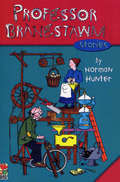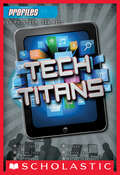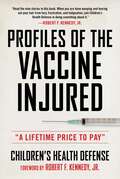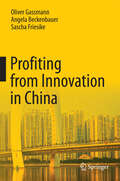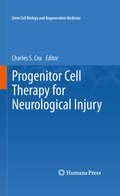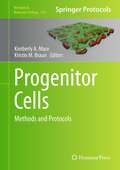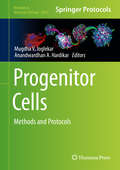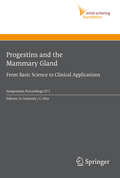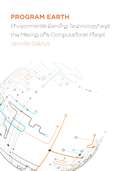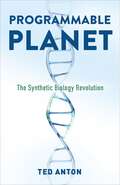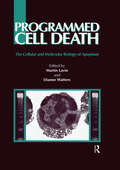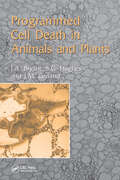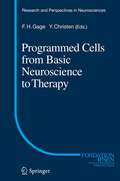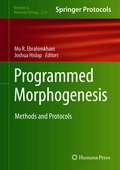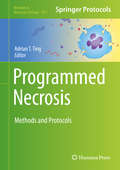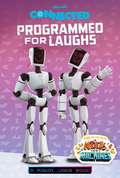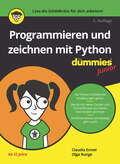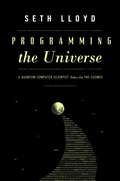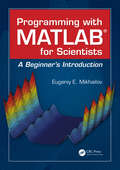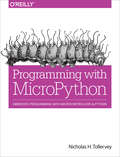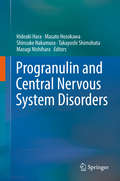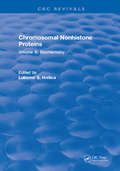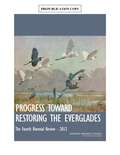- Table View
- List View
Professor Branestawm Stories
by Norman HunterHe's madly sane and cleverly dotty. Professor Branestawm is the craziest genius you'll ever meet and he's back with this bumper collection of hilarious adventures, zany inventions and mind-boggling experiments. So open up for a wacky collection of stories, riddles, puzzles, tricks and tips . . . You'll never get the better of Professor Branestawn but now you can at least get the best!
Profiles #3: Tech Titans (Profiles #3)
by Carla Killough McclaffertyFull-color series-six bios in one! It takes more than one person to bring about change and innovation. Explore the lives of the people who have had a huge impact on technology today. So much more than just your typical biography, PROFILES: TECH TITANS focuses on six of the most prominent figures in the technological world. This book includes all of the biographical information kids need to know (background, family, education, accomplishments, etc.) about Bill Gates, Steve Jobs, Mark Zuckerberg, Larry Page, Sergey Brin, and Jeff Bezos--the men behind Windows, Apple, Facebook, Google, and Amazon! Photographs and quotes will be interwoven throughout the text.
Profiles of the Vaccine-Injured: "A Lifetime Price to Pay" (Children’s Health Defense)
by Robert F. Kennedy Jr. Children's Health DefenseAre vaccine injuries really &“one in a million,&” as governments and public health experts constantly tell us? This comprehensive look at the evidence by Children&’s Health Defense, illustrated by nine real-life stories of serious vaccine injury, exposes health agencies&’ soft-pedaling of vaccine risks as a dangerous lie. For most people, the potential risks of vaccination, which include life-changing illness, family bankruptcy, and even death, are invisible and almost inconceivable—until a vaccine injury happens to them. Through the poignant and riveting stories of nine injured children and adults, Profiles of the Vaccine-Injured by Children&’s Health Defense communicates the devastating impacts of vaccine damage on health, family finances, relationships, and more. As the book&’s introductory chapters show, vaccine injuries—whether from a routine childhood injection—or a travel vaccine—or a COVID-19 shot—are common, not rare. Discussing US children&’s poor showing in global health rankings, the book assembles compelling evidence pointing to childhood vaccination as a key &“elephant in the room.&” The heart of the book resides in the vaccine injury stories told by mothers of injured children and injured adults. Conveying in vivid detail what it&’s like to live with conditions such as severe autism, chronic pain, and immune systems gone haywire, the nine individuals also attest to the disturbing fact that &“when it comes to vaccine injuries, there&’s no help legally or financially—you&’re on your own.&” In addition, they share affecting accounts of gaslighting, a lack of answers or solutions and outright hostility from the medical community, social isolation, heavy financial burdens, and interrupted careers and lives. Exposing the truth behind the vaccine safety myth, Profiles of the Vaccine-Injured makes vaccine injury personal and demonstrates that we ignore vaccine risks at our peril.
Profiting from Innovation in China
by Oliver Gassmann Sascha Friesike Angela BeckenbauerChina is dramatically catching up and is rapidly becoming a leading technological innovator on the global scale. The number of Chinese firms with global ambitions is growing fast, more and more technological innovation is coming from China, and the number of patents in China is also growing steadily. The negative side of this development is the still insufficient protection of intellectual property in China. The phenomenon of counterfeits originating from China has increased constantly over the past two decades. Moreover, within the past ten years the scale of intellectual property theft has risen exponentially in terms of its sophistication, volume, the range of goods, and the countries affected. This book addresses managers dealing with innovation in China, and offers concrete advice on how Western firms can benefit from these innovations. Among others, it provides examples and checklists to help decision-makers active in China.
Progenitor Cell Therapy for Neurological Injury
by Charles S. Cox Jr.There are currently no reparative therapies for severe neurological injury, including brain injury, spinal cord injury and stroke. Actually, most treatments are designed simply to limit secondary damage. However, pre-clinical data supports the idea that exogenous stem and progenitor cells have the potential to promote a reparative response to severe neurological injuries. Progenitor Cell Therapy for Neurological Injury is a compilation of seminal essays that explore many unique aspects of neurological injury, focusing on the critical translational issues of cell delivery. Specifically, it discusses routes of administration, types of progenitor cells (alone and/or in combinations), timing of delivery and adjuncts to promote cell engraftment, survival and effectiveness. In addition, many chapters address measuring the effects of transplanted cells and cell tracking. The paradigms of how cell-based therapeutics affect neurological injury is changing rapidly. The developments in this field may ultimately offer realistic hope for improvement in patients with severe injuries. This book is a vital key toward unlocking those future treatments.
Progenitor Cells
by Kimberly A. Mace Kristin M. BraunProgenitor cells have become important in regenerative medicine therapies, due to their potential to differentiate into many cell types. This capability, and understanding how to regulate the cells, will provide the basis for future cell therapies aimed at correcting tissue and organ dysfunction as a result of disease or injury. In, Progenitor Cells: Methods and Protocols, expert researchers in the field detail many of the methods which are now commonly used to investigate progenitor cells. These include methods and techniques of the manipulation of physical forces that shape progenitor cell behavior, studying progenitor cells in vivo, using non-mammalian and mammalian model systems, and investigating human progenitor cells, including their isolation, characterization and application in cell-based therapies. Written in the highly successful Methods in Molecular BiologyTM series format, chapters include introductions to their respective topics, lists of the necessary materials and reagents, step-by-step, readily reproducible laboratory protocols, and key tips on troubleshooting and avoiding known pitfalls. Authoritative and practical, Progenitor Cells : Methods and Protocols seeks to aid scientists in the further study progenitor cells and how they are studied across multiple systems.
Progenitor Cells: Methods and Protocols (Methods in Molecular Biology #2029)
by Anandwardhan A. Hardikar Mugdha V. JoglekarThis volume explores the diversity in progenitor cell biology methods and uniquely describes techniques for isolating, generating, and characterizing progenitor cells from either tissue or embryonic stem cells. The chapters in this book cover topics such as isolating progenitor cells from sources including adipose tissue, blood, bone marrow, ear, gut, heart, pancreatic islets, and Whirton’s jelly; deriving neural, pancreatic, and urothelial precursors from the embryonic stem cells; and culturing isolated islets in vitro to generate progenitor cells via epithelial-to-mesenchymal transition. This book also delves into digital droplet PCR; flow cytometry and cell sorting; mitochondrial assays; calcium ratiometric signaling; and 2D gel electrophoresis. Written in the highly successful Methods in Molecular Biology series format, chapters include introductions to their respective topics, lists of the necessary materials and reagents, step-by-step, readily reproducible laboratory protocols, and tips on troubleshooting and avoiding known pitfalls.Cutting-edge and thorough, Progenitor Cells: Methods and Protocols is a valuable resource for scientists and researchers interested in learning more about this evolving and diverse field.
Progestins and the Mammary Gland
by Orla M. Conneely Christiane OttoProgestins play a key role in reproductive endocrinology and as pharmaceutical drugs for contraception and in combined hormone therapy. To further our understanding of progestin action in the mammary gland, an international symposium, attended by leading researchers from academia and industry, was held in Berlin, 21-23 March 2007. Genetic mouse models helped to elucidate the role of progestins, both in normal breast development and in disease. Mechanistic molecular studies inspired the design of new progestins with improved tissue selectivity. In addition, the clinical impact of progesterone receptor agonists and antagonists for the prevention and treatment of breast cancer was discussed.
Program Earth: Environmental Sensing Technology and the Making of a Computational Planet (Electronic Mediations #49)
by Jennifer GabrysSensors are everywhere. Small, flexible, economical, and computationally powerful, they operate ubiquitously in environments. They compile massive amounts of data, including information about air, water, and climate. Never before has such a volume of environmental data been so broadly collected or so widely available.Grappling with the consequences of wiring our world, Program Earth examines how sensor technologies are programming our environments. As Jennifer Gabrys points out, sensors do not merely record information about an environment. Rather, they generate new environments and environmental relations. At the same time, they give a voice to the entities they monitor: to animals, plants, people, and inanimate objects. This book looks at the ways in which sensors converge with environments to map ecological processes, to track the migration of animals, to check pollutants, to facilitate citizen participation, and to program infrastructure. Through discussing particular instances where sensors are deployed for environmental study and citizen engagement across three areas of environmental sensing, from wild sensing to pollution sensing and urban sensing, Program Earth asks how sensor technologies specifically contribute to new environmental conditions. What are the implications for wiring up environments? How do sensor applications not only program environments, but also program the sorts of citizens and collectives we might become?Program Earth suggests that the sensor-based monitoring of Earth offers the prospect of making new environments not simply as an extension of the human but rather as new &“technogeographies&” that connect technology, nature, and people.
Programmable Planet: The Synthetic Biology Revolution
by Ted AntonA new science is reengineering the fabric of life. Synthetic biology offers bold new ways of manufacturing medicines, clothing, foods, fragrances, and fuels, often using microbe fermentation, much like brewing beer. The technology can help confront climate change, break down industrial pollutants, and fight novel viruses. Today, researchers are manipulating life forms and automating evolution to create vegetarian “meat,” renewable construction materials, and cancer treatments. In the process, they are changing our concept of what life science can achieve. Is this a new industrial and information revolution—or dangerous tinkering that could unleash unintended consequences?Programmable Planet is a grand tour through the world of synthetic biology, telling the stories of the colorful visionaries whose ideas are shaping discoveries. Ted Anton explores the field from its beginning in fighting malaria in Africa to the COVID vaccines and beyond. Covering medical and agricultural triumphs and blunders, he examines successes in energy production, plant gene editing, and chemical manufacturing, as well as the most controversial attempts at human gene enhancement. This book reports from the front lines of research, showing policy makers’ struggle to stay abreast of the technologies they aim to regulate. Even-handed, lively, and informative, Programmable Planet gives a glimpse of the promise and problems of a new biology-based industry.
Programmed Cell Death
by Hamsa Puthalakath Christine J. HawkinsThis volume containsprotocols specifically designed for studying programmed cell death, and alsodiscusses recent advances in techniques that span broader areas of biology thathave been recently used or that have potential to be incorporated into cell deathresearch. The protocols are mostly described in the context of mammaliansystems, but also cover other systems such as plants, Drosophila, andyeast. Programmed Cell Death: Methods and Protocols is comprised of 20chapters: Chapters 1-5 describe apoptosis detection techniques; Chapter 6-9describe methods for studying apoptosis associated with various pathologies indifferent organs including the lymphoid compartment, intestinal epithelium,granulocytes, and cardiomyocytes; Chapter 11-13 cover protocols and techniquesfor studying apoptosis in non-mammalian systems; Chapters 14-16 coverbiochemical and biophysical methods for studying Bcl-2 family protein dynamicsand protein-protein interactions during apoptosis; and the last four chaptersexplore protocols that are useful not only in apoptosis research but in widerareas of biological research, such as genome editing, inducible transgenes, andproteomics. Written in the highly successful Methods in Molecular Biologyaeries format, chapters include introductions to their respective topics, listsof the necessary material and reagents, step-by-step, readily reproduciblelaboratory protocol, and tips on troubleshooting and avoiding known pitfalls. Thoroughand cutting-edge, Programmed Cell Death: Methods and Protocols is acomprehensive and valuable resource for researchers, ranging from beginner toexpert, in their studies on programmed cell death.
Programmed Cell Death
by Martin Lavin Diane WattersAlthough general morphological features have been used to consistently identify the changes in cell ultrastructure occurring during apoptosis, as distinct from necrosis, important advances have been achieved more recently in the investigation of the cellular and molecular aspects of this process. This book brings together the latest international research on the complex subject of programmed cell death, and covers such areas as the biochemical mechanisms, introduction of DNA fragmentation, enetic regulation, and the importance of apoptosis in the immune system, particularly during T-cell development, and in cancer. The comparison of a number of common signal transduction pathways with those involved in cell growth highlights an important relationship between apoptosis and the control of cell proliferation.
Programmed Cell Death in Animals and Plants (Society For Experimental Biology Ser.)
by J. A. Bryant S. G. Hughes J. M. GarlandThis title, the 52nd in symposium series, presents a comprehensive review of apoptosis and features contributions from many internationally recognised authors. The book is the first to integrate programmed cell death in plants, invertebrates and vertebrates. Rapid publication ensures that the very latest research is included.
Programmed Cells from Basic Neuroscience to Therapy
by Yves Christen Fred H. GageThe recent advances in Programming Somatic Cell (PSC) including induced Pluripotent Stem Cells (iPS) and Induced Neuronal phenotypes (iN), has changed our experimental landscape and opened new possibilities. The advances in PSC have provided an important tool for the study of human neuronal function as well as neurodegenerative and neurodevelopmental diseases in live human neurons in a controlled environment. For example, reprogramming cells from patients with neurological diseases allows the study of molecular pathways particular to specific subtypes of neurons such as dopaminergic neurons in Parkinson's Disease, Motor neurons for Amyolateral Sclerosis or myelin for Multiple Sclerosis. Detecting disease-specific molecular signatures in live human brain cells, opens possibilities for early intervention therapies and new diagnostic tools. Importantly, once the neurological neural phenotype is detected in vitro, the so-called "disease-in-a-dish" approach allows for the screening of drugs that can ameliorate the disease-specific phenotype. New therapeutic drugs could either act on generalized pathways in all patients or be patient-specific and used in a personalized medicine approach. However, there are a number of pressing issues that need to be addressed and resolved before PSC technology can be extensively used for clinically relevant modeling of neurological diseases. Among these issues are the variability in PSC generation methods, variability between individuals, epigenetic/genetic instability and the ability to obtain disease-relevant subtypes of neurons . Current protocols for differentiating PSC into specific subtypes of neurons are under development, but more and better protocols are needed. Understanding the molecular pathways involved in human neural differentiation will facilitate the development of methods and tools to enrich and monitor the generation of specific subtypes of neurons that would be more relevant in modeling different neurological diseases.
Programmed Morphogenesis: Methods and Protocols (Methods in Molecular Biology #2258)
by Mo R. Ebrahimkhani Joshua HislopThis detailed book explores techniques for understanding and engineering programs that naturally control and drive formation of tissues and organs in order to open powerful opportunities to produce physiologically relevant tissues of interest, generate models to study human disease, and set the path for the manufacturing of advanced tissue and organs. Beginning with chapters to help understand signaling events and patterns in morphogenetic systems, the volume continues by covering programming signaling events and patterns to drive morphogenesis, techniques for engineering organoids, tissue barriers, and disease models, as well as in vivo therapeutic applications. Written for the highly successful Methods in Molecular Biology series, chapters include introductions to their respective topics, lists of the necessary materials and reagents, step-by-step, readily reproducible laboratory protocols, and tips on troubleshooting and avoiding known pitfalls. Authoritative and cutting-edge, Programmed Morphogenesis: Methods and Protocols aims not only to communicate knowledge but also to inspire approaches to new challenges and to empower readers with the capability to approach those challenges.
Programmed Necrosis
by Adrian T. TingThis volume explores the latest techniques and approaches used to study this emerging form of cell death. The chapters in this book cover topics such as distinguishing necroptosis from apoptosis; detecting MLKL oligomerization during programmed necrosis; analyzing the RIPK3 necrosome complex; using RIPK1 kinase small molecule inhibitors in studying necroptosis; monitoring RIPK1 phosphorylation in the TNFR1 signaling complex; and assessing in vivo kidney cell death in glomerular injury. Written in the highly successful Methods in Molecular Biology series format, chapters include introductions to their respective topics, lists of the necessary materials and reagents, step-by-step, readily reproducible laboratory protocols, and tips on troubleshooting and avoiding known pitfalls.Cutting-edge and thorough, Programmed Necrosis: Methods and Protocols is a valuable resource for technicians, graduate students, postdoctoral fellows, and other scientists who are pursuing studies in this field.
Programmed for Laughs: A Robot Joke Book (Connected, based on the movie The Mitchells vs. the Machines)
by Matt ChapmanIn this joke book companion to the hilarious and offbeat motion picture The Mitchells vs. the Machines from Sony Pictures Animation, robots Eric and Deborahbot 5000 team up to write robot jokes with side-splitting results!When the delightfully dysfunctional Mitchell family&’s road trip is interrupted by a worldwide tech uprising, they join forces with two hilarious malfunctioning robots to save humanity before it&’s too late. In this book, robots Eric and Deborahbot 5000 form a team of their own as they crack jokes about the Mitchell family&’s accidental heroism and what the robot apocalypse is really like. This laugh-out-loud joke book will leave readers of all ages snorting, spitting out their drinks, and otherwise malfunctioning!
Programmieren und zeichnen mit Python für Dummies Junior (Für Dummies)
by Claudia Ermel Olga RungeBunte Spiralen, Schneeflocken unter dem Mikroskop, 3D-Bilder? Mit diesem Buch lernst du, immer schönere Bilder mit dem Computer zu zeichnen. Es fängt ganz leicht an: Zuerst lässt du die Schildkröte, die deinen Pinsel hält, einfach nur über den Bildschirm laufen. Als nächstes bringst du ihr bei, ein Dreieck zu zeichnen. Wenn du ein Dreieck zeichnen kannst, kannst du auch ganz viele zeichnen, denn die Schildkröte nimmt dir die Arbeit ab. Dann kombinierst du Dreiecke zu Mosaiken und lässt Blumen und Bäume wachsen. Noch nicht genug? Zeichne 3D-Bilder und optische Täuschungen, animiere die Schildkröte, lasse sie Futter suchen oder steuere sie durch ein Labyrinth. Du hast noch mehr Ideen für eigene Bilder oder Spiele? Dieses Buch liefert dir die Python-Programmierbefehle dazu. Bestens geeignet für Kinder und Jugendliche ab 12 Jahre.
Programming the Universe
by Seth LloydThe universe is made of bits. The way in which the universe registers and processes information determines what it is and how it behaves. It has been known for more than a century that every piece of the universe - every electron, atom, and molecule - registers bits of information. It is only in the last ten years, however, with the discovery and development of quantum computers, that scientists have gained a fundamental understanding of just how that information is registered and processed. Seth Lloyd calls this fundamental understanding of the universe in terms of information processing 'the computational universe', and the purpose of this book is to show how the programmed, computational universe works. Starting from basic concepts of physics, Programming the Universe shows how all physical systems register information. It gives an accessible account of how information is stored and processed at the level of electrons, atoms, and molecules. It shows how the information processing power of the universe can be harnessed to build quantum computers and explains how the universe itself behaves like a gigantic computer, transforming and processing information. It traces the history of information processing from the big bang to the present day, and reveals how the computational ability of the universe promotes the evolution of complex structures such as life. Programming the Universe is the story of the universe and the bits it is made of.
Programming with MATLAB for Scientists: A Beginner’s Introduction
by Eugeniy E. Mikhailov<p>This book offers an introduction to the basics of MATLAB programming to scientists and engineers. The author leads with engaging examples to build a working knowledge, specifically geared to those with science and engineering backgrounds. The reader is empowered to model and simulate real systems, as well as present and analyze everyday data sets. In order to achieve those goals, the contents bypass excessive "under the hood" details, and instead gets right down to the essential, practical foundations for successful programming and modeling. Readers will benefit from the following features: <li>Teaches programming to scientists and engineers using a problem-based approach, leading with illustrative and interesting examples. <li>Emphasizes a hands-on approach, with "must know" information and minimal technical details. <li>Utilizes examples from science and engineering to showcase the application of learned concepts on real problems. <li>Showcases modeling of real systems, gradually advancing from simpler to more challenging problems. <li>Highlights the practical uses of data processing and analysis in everyday life.</li>
Programming with MicroPython: Embedded Programming with Microcontrollers and Python
by Nicholas H. TollerveyIt’s an exciting time to get involved with MicroPython, the re-implementation of Python 3 for microcontrollers and embedded systems. This practical guide delivers the knowledge you need to roll up your sleeves and create exceptional embedded projects with this lean and efficient programming language. If you’re familiar with Python as a programmer, educator, or maker, you’re ready to learn—and have fun along the way.Author Nicholas Tollervey takes you on a journey from first steps to advanced projects. You’ll explore the types of devices that run MicroPython, and examine how the language uses and interacts with hardware to process input, connect to the outside world, communicate wirelessly, make sounds and music, and drive robotics projects.Work with MicroPython on four typical devices: PyBoard, the micro:bit, Adafruit’s Circuit Playground Express, and ESP8266/ESP32 boardsExplore a framework that helps you generate, evaluate, and evolve embedded projects that solve real problemsDive into practical MicroPython examples: visual feedback, input and sensing, GPIO, networking, sound and music, and roboticsLearn how idiomatic MicroPython helps you express a lot with the minimum of resourcesTake the next step by getting involved with the Python community
Progranulin and Central Nervous System Disorders
by Hideaki Hara Masato Hosokawa Shinsuke Nakamura Takayoshi Shimohata Masugi NishiharaThis book presents the latest knowledge on the roles of progranulin (PGRN) in normal physiology and pathology and explores the emerging significance of PGRN as a therapeutic target and biomarker in various CNS disorders, including frontotemporal lobe degeneration and other neurodegenerative diseases. Following initial recognition of the importance of PGRN in sexual differentiation of the developing brain and adult neurogenesis, it was subsequently discovered that PGRN acts as a chaperone of lysosomal enzymes and plays a crucial role in maintaining cellular protein homeostasis. It has also been found that sex steroids modulate the expression of PGRN and its trophic effects in the developing CNS and that PGRN directly or indirectly influences neural stem and progenitor cells. Against this background, deeper understanding of the molecular and functional properties of PGRN would provide fresh impetus for the development of mechanism-based therapeutic approaches for multiple disorders. Medications targeting the recovery of lysosomal function appear to hold particular promise in patients with neurodegenerative diseases resulting from PGRN insufficiency. In examining multiple aspects of this fascinating field, the book will be of high value for researchers and graduate students.
Progranulin: Methods and Protocols (Methods in Molecular Biology #1806)
by Andrew Bateman Hugh P.J. Bennett Siu Tim CheungThis volume explores experimental strategies to study progranulin as a regulatory protein in biological and disease processes. The chapters in this book are divided into four parts: Part One is an introduction to the topic; Part Two looks at analytical and in vitro methods to study progranulin biology; Part Three discusses the role of progranulin in cancer; and Part Four describes the process of using animal models to study progranulin in health and disease. Written in the highly successful Methods in Molecular Biology series format, chapters include introductions to their respective topics, lists of the necessary materials and reagents, step-by-step, readily reproducible laboratory protocols, and tips on troubleshooting and avoiding known pitfalls.Cutting-edge and thorough, Progranulin: Methods and Protocols is a valuable resource for experienced researchers who want to expand their studies of this field, and newcomers who want to begin including progranulin into their work.
Progress In Nonhistone Protein Research: Volume III
by I. BekhorAs a follow-up to Volumes I and II in this series, in this volume the authors attempt to provide an update into the current research in NHCP with the hope that these articles may foster a more analytical elucidation of the role of these proteins in gene expression.
Progress Toward Restoring the Everglades
by National Research Council Water Science and Technology Board Division on Earth and Life Studies Board on Environmental Studies and Toxicology Committee on Independent Scientific Review of Everglades Restoration ProgressTwelve years into the Comprehensive Everglades Restoration Project, little progress has been made in restoring the core of the remaining Everglades ecosystem; instead, most project construction so far has occurred along its periphery. To reverse ongoing ecosystem declines, it will be necessary to expedite restoration projects that target the central Everglades, and to improve both the quality and quantity of the water in the ecosystem. The new Central Everglades Planning Project offers an innovative approach to this challenge, although additional analyses are needed at the interface of water quality and water quantity to maximize restoration benefits within existing legal constraints. Progress Toward Restoring the Everglades: The Fourth Biennial Review, 2012 explains the innovative approach to expedite restoration progress and additional rigorous analyses at the interface of water quality and quantity will be essential to maximize restoration benefits.
